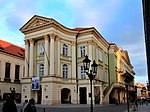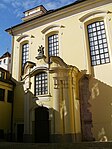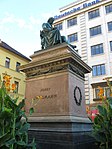Divadlo v Kotcích

The Divadlo v Kotcích, German Theater an der Kotzen, in English more usually Kotzen Theatre, was a Prague theatre and opera venue on v Kotcích street, which had its heyday 1739-1783 as the second public opera theatre in Prague. Spoken plays and ballets were also presented there. For many seasons it was run by the Italian impresario Santo Lapis, then Giovanni Battista Locatelli, who staged Gluck's Prague Ezio, 1750, and other works. Later impresarios who worked there include Gaetano Molinari and Giuseppe Bustelli. The more correct "Theater an der Kotzen" was often colloquially referred to as the "Kotzentheater," Kotzen being a Slavonic-German term for a market. It closed in 1783 for safety reasons.It was preceded by the opera theatre of Count Franz Anton von Sporck, which operated between 1724 and 1735, and succeeded by Count Nostitz's "National Theatre," now the Estates Theatre (or "Stavovské divadlo"), which opened on 21 April 1783. The current National Theatre, "Národní divadlo" did not open until 1881.
Excerpt from the Wikipedia article Divadlo v Kotcích (License: CC BY-SA 3.0, Authors, Images).Divadlo v Kotcích
Havelská, Prague Old Town
Geographical coordinates (GPS) Address Phone number Website Nearby Places Show on map
Geographical coordinates (GPS)
| Latitude | Longitude |
|---|---|
| N 50.085111111111 ° | E 14.42205 ° |
Address
Česká spořitelna
Havelská
110 00 Prague, Old Town
Prague, Czechia
Open on Google Maps











